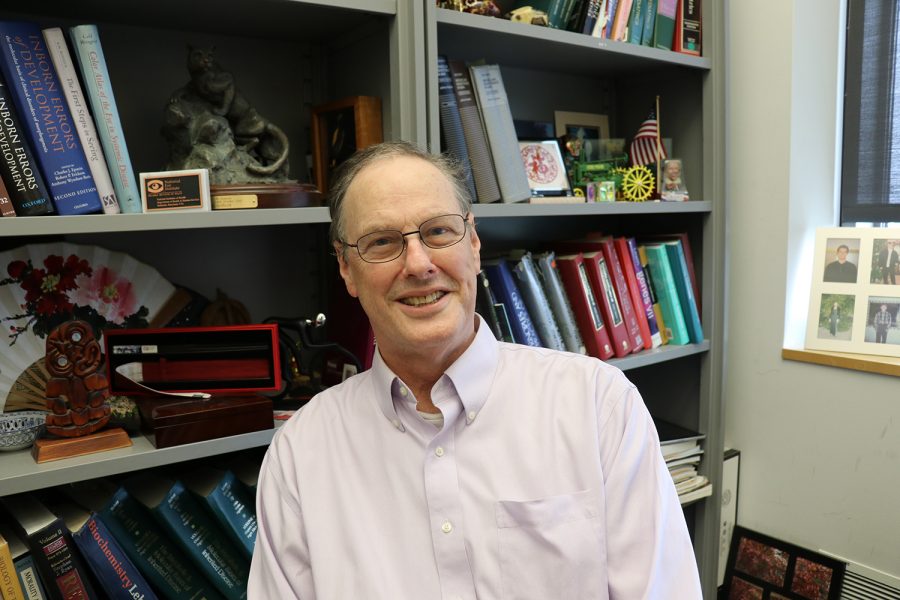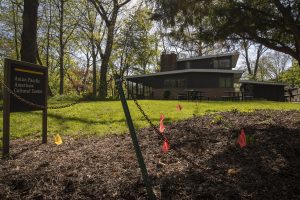University of Iowa molecular genetics researcher studying COVID-19 testing methods to alleviate test shortages
Amid the COVID-19 pandemic, Val Sheffield is pivoting his research focus to find a way to test patients without using high demand cotton swabs.
May 6, 2020
University of Iowa Molecular Genetics Chair in the Carver College of Medicine Val Sheffield has made research breakthroughs in linking gene research and was recently named to a prestigious American research institute’s class of 2020.
But amid the COVID-19 pandemic, Sheffield is pivoting his work to research an alternate way to test patients for novel coronavirus to alleviate a nationwide shortage of the parts in a COVID-19 test.
Sheffield and his team submitted a document April 1 to the FDA requesting emergency-use authorization to utilize a patient-sample collection method for COVID-19 testing.
“My laboratory decided early on that we have the capability to help with [COVID-19] testing,” Sheffield said. “Testing is really important, but it’s behind where it should be… because there aren’t enough official, FDA-approved swabs to collect samples from patients… For the last month we’ve been trying to get FDA approval for our testing method where patients snort through the nose and spit into a tube, and the saliva sample is tested for the virus.”
When the method is approved by the FDA, Sheffield said researchers can use it to test anyone. The most common coronavirus tests involve inserting a long cotton swab into a patient’s nostril. Sheffield anticipates beginning testing soon, with a limited number of patients in a study that will be the final step in getting FDA approval.
Iowa Gov. Kim Reynolds launched Test Iowa, a partnership between the state and private technology companies Domo, Qualtrics, and NomiHealth. But, the Test Iowa equipment was pending certification by the State Hygienic Lab to run tests as of Friday.
In Iowa, tests are being prioritized for those over the age of 60, with chronic health conditions, are in the hospital, or live in congregate living facilities such as a nursing home.
Iowa has tested more than 63,000 people and reported more than 10,000 cases as of Wednesday. Reynolds is using widespread testing as a signal that the state can begin the steps of reopening, seemingly going against the advice of University of Iowa researchers, who concluded that a second wave of COVID-19 cases could emerge without precautions in place.
In late April, amid his shifting work, Sheffield was elected to the 2020 class of the American Academy of Arts and Sciences.
Sheffield began as a faculty member at the UI 30 years ago and contributes to campus clinical work and research. He started as an assistant professor and has since branched out to administrative work, instruction, and research. He served as the UI Division Director of Medical Genetics for 22 years and stepped down in January to spend more time on research.
RELATED: National registrar association awards Sarah Harris with honorary membership after 30 years at UI
Sheffield has co-authored 330 peer-reviewed scientific papers, and said he has found supportive and outstanding collaborators who have been pivotal to his research’s success in his time at the UI.
“My research focuses on hereditary blindness,” he said. “I’ve worked on identifying genes that play a role in hereditary blindness. More recently, my team and I have been focusing on figuring out mechanisms by which mutations cause disease and developing treatments.”
Sheffield said that his election has reinforced his obligation to serve and help others with his science. This will continue to fuel his desire to work hard and continue to further his research, Sheffield said.
David Ginsburg, James V. Neel Distinguished university professor at the University of Michigan Medical School, is also a member of the American Academy of Arts and Sciences. He first met Sheffield at the Howard Hughes Medical Institution.
Ginsburg said Sheffield’s research has been crucial to developing human genetic maps. Only a few academic scientists are elected to the U.S. organization a year, and Ginsburg said Sheffield’s election was well deserved.
“Val is a fantastic physician scientist,” Ginsburg said. “He’s done landmark work figuring out what gene is defective for a whole variety of different, rare genetic diseases. He was one of the real pioneers tracking down these genes. He identified where the corresponding disease gene is located in our chromosomes for about 35 diseases… When I was in medical school, we only knew the responsible gene for one human disease… Today, we know the gene for about 6,000 human diseases, and Val was one of the early leaders in this work.”
Ginsburg said he has seen how much members of the organization can grow once they’re inducted. Sheffield will be able to continue expanding his horizons in academia when he is inducted next spring, he added.
“A big part of what drives what we do in academic medicine is interaction with colleagues and the new ideas that you get when meeting, talking, and interacting with colleagues in diverse fields,” he said. “That’s one of the greatest things the American Academy has to offer. I know it will give Val an opportunity to expand his research and intellectual contributions to the academic enterprise.”
According to the American Academy of Arts and Sciences website, the 240-year-old American Academy of Arts and Sciences was founded by John Adams and John Hancock and aims to recognize scholars and leaders in various disciplines. Sheffield joins 11 other Hawkeyes already in the organization, including UI Cardiovascular Research Chair and Professor Francois Abboud.
Abboud said Sheffield, who he has known since 1990, is an internationally recognized leader in the field of human molecular genetics and genomics as well as someone he admires.
“[Sheffield] is more than a great scientist,” Abboud said. “I’ve always been impressed by his true commitment to his patients. What drives his scientific research is his extraordinary commitment to the patients. Science is his true passion. He is a brilliant scientist and an even more remarkable person.”






